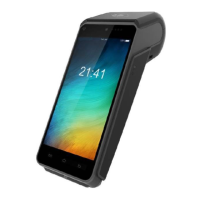
Do you have a question about the Ingenico group AXIUM DX8000-BASE-W2 and is the answer not in the manual?
| Ports | USB-C |
|---|---|
| Processor | Cortex A53 Quad-Core |
| Operating System | Android |
| Memory | 2GB RAM, 8GB Flash |
| Connectivity | 4G, Wi-Fi, Bluetooth |
| Card Readers | EMV, NFC, Magnetic Stripe |
| Payment Options | Contactless, Chip & PIN, Magstripe |
| Security | PCI PTS 5.x |
| Camera | 5MP rear camera |
Check package contents for damage and list items like base host, instructions, and power adapter.
Identifies and labels the ports and buttons on the base unit with numbered callouts.
Details the pinout for RJ45, USB-A, and USB-B interfaces.
Lists port types, power specifications, and physical dimensions/weights of the base.
Specifies operating, storage, and delivery conditions for temperature, humidity, and atmospheric pressure.
Outlines the three main functions: charging DX8000, extended communication ports, and host communication.
Step-by-step guide to connecting the DX8000 device to the base station's WiFi network.
Instructions for accessing the base station's web interface for configuration via WiFi.
Explains conditions for pairing, indicator lights, and how to reset pairing records.
Details the step-by-step process for pairing the DX8000 with the base station.
Guides on how to disconnect or unpair a DX8000 device from the base station.
Instructions for configuring WAN and LAN parameters for Ethernet connection.
Guide to setting up 2.4GHz and 5GHz WLAN parameters like channel and RF power.
Covers setting operating mode, DMZ, and static DHCP configurations for the base.
Instructions for upgrading firmware and managing base settings via the management menu.
Addresses common causes and solutions for connection failures between the base and DX8000.
Explains why the base might show as disconnected despite a flashing green light.
Details supported USB devices and troubleshooting for unrecognized USB peripherals.
Describes the process of re-pairing or pairing a new DX8000 to an already paired base.
Advices on protecting the device from environmental factors and handling abnormal operations.
Instructions for proper delivery methods and storage conditions to maintain product integrity.
Emphasizes using only the provided power adapter and potential damage from using alternatives.
States compliance with FCC rules and conditions for operation to avoid harmful interference.
Details compliance with Innovation, Science and Economic Development Canada regulations for radio devices.
Specifies RF exposure limits and minimum safe distances for installation and operation.
Information on waste electrical and electronic equipment, batteries, and packaging disposal.